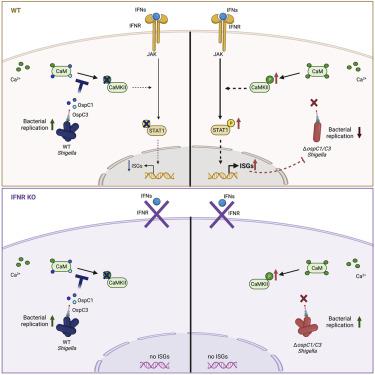Cell ( IF 45.5 ) Pub Date : 2022-05-13 , DOI: 10.1016/j.cell.2022.04.028 Noémie Alphonse 1 , Joseph J Wanford 2 , Andrew A Voak 2 , Jack Gay 2 , Shayla Venkhaya 2 , Owen Burroughs 2 , Sanjana Mathew 2 , Truelian Lee 3 , Sasha L Evans 4 , Weiting Zhao 2 , Kyle Frowde 2 , Abrar Alrehaili 2 , Ruth E Dickenson 2 , Mads Munk 5 , Svetlana Panina 5 , Ishraque F Mahmood 2 , Miriam Llorian 6 , Megan L Stanifer 7 , Steeve Boulant 7 , Martin W Berchtold 5 , Julien R C Bergeron 4 , Andreas Wack 8 , Cammie F Lesser 9 , Charlotte Odendall 2

|
Interferons (IFNs) induce an antimicrobial state, protecting tissues from infection. Many viruses inhibit IFN signaling, but whether bacterial pathogens evade IFN responses remains unclear. Here, we demonstrate that the Shigella OspC family of type-III-secreted effectors blocks IFN signaling independently of its cell death inhibitory activity. Rather, IFN inhibition was mediated by the binding of OspC1 and OspC3 to the Ca2+ sensor calmodulin (CaM), blocking CaM kinase II and downstream JAK/STAT signaling. The growth of Shigella lacking OspC1 and OspC3 was attenuated in epithelial cells and in a murine model of infection. This phenotype was rescued in both models by the depletion of IFN receptors. OspC homologs conserved in additional pathogens not only bound CaM but also inhibited IFN, suggesting a widespread virulence strategy. These findings reveal a conserved but previously undescribed molecular mechanism of IFN inhibition and demonstrate the critical role of Ca2+ and IFN targeting in bacterial pathogenesis.
中文翻译:

一系列保守的细菌毒力因子通过阻断钙信号传导来抑制干扰素反应
干扰素 (IFN) 会诱导抗菌状态,保护组织免受感染。许多病毒抑制 IFN 信号传导,但细菌病原体是否逃避 IFN 反应仍不清楚。在这里,我们证明了志贺氏菌OspC 家族的 III 型分泌效应子能够独立地阻断 IFN 信号传导,而与其细胞死亡抑制活性无关。相反,IFN 抑制是通过 OspC1 和 OspC3 与 Ca 2+传感器钙调蛋白 (CaM) 的结合介导的,从而阻断 CaM 激酶 II 和下游 JAK/STAT 信号传导。缺乏 OspC1 和 OspC3 的志贺氏菌在上皮细胞和小鼠感染模型中的生长减弱。通过消除干扰素受体,该表型在两种模型中都得到了挽救。其他病原体中保守的 OspC 同源物不仅结合 CaM,还抑制 IFN,表明存在广泛的毒力策略。这些发现揭示了 IFN 抑制的保守但先前未描述的分子机制,并证明了 Ca 2+和 IFN 靶向在细菌发病机制中的关键作用。











































 京公网安备 11010802027423号
京公网安备 11010802027423号